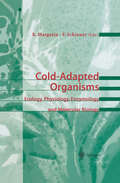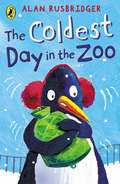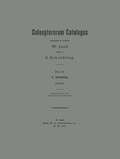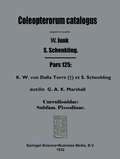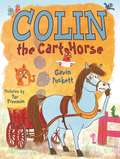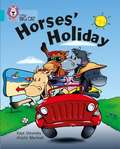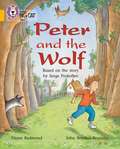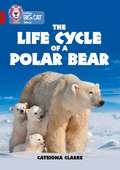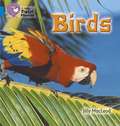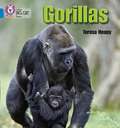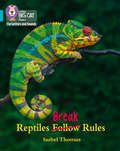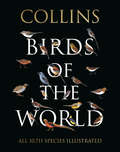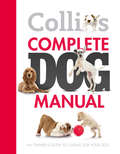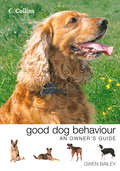- Table View
- List View
Cognitive Processes and Spatial Orientation in Animal and Man: Volume I Experimental Animal Psychology and Ethology (NATO Science Series D: #36)
by Paul Ellen and Catherine Thinus-BlancThese volumes represent the proceedings of NATO Advanced Study Institute on the topic of "Cognitive Processes and Spatial Orientation in Animal and Man" held at La-Baume-les-Aix, Aix-en-Provence, France, in June-July 1985. The motivation underlying this Institute stemmed from the recent advances and interest in the problems of spatial behavior. In Psychology, traditional S-R concepts were found to be unsatisfactorY for fully accounting for the complexity of spatial behavior. Coupled with the decline in such an approach, has been a resurgence of interest in cognitive types of concepts. In Ethology, investigators have begun to use more sophisticated methods for the study of homing and navigational behaviors. In the general area of Neuroscience, marked advances have been achieved in the understanding of the neural mechanisms underlying spatial behaviors. And finally, there has been a burgeoning interest and body of knowledge concerning the development of spatial behavior in humans. All of these factors combined to suggest the necessity of bringing together scientists working in these areas with the intent that such a meeting might lead to a cross-fertilization of the various areas. Possibly by providing a context in which members of the various disciplines could interact, it was felt that we might increase the likelihood of identifying those similarities and differences in the concepts and methods common to all groups. Such an identification could provide the basis for a subsequent interdisciplinary research effort.
Coherent Behavior in Neuronal Networks (Springer Series in Computational Neuroscience #3)
by Krešimir Josić Jonathan Rubin Manuel A. Matías Ranulfo RomoRecent experimental research advances have led to increasingly detailed descriptions of how networks of interacting neurons process information. With these developments, it has become clear that dynamic network behaviors underlie information processing, and that the observed activity patterns cannot be fully explained by simple concepts such as synchrony and phase locking. These new insights raise significant challenges and offer exciting opportunities for experimental and theoretical neuroscientists. Coherent Behavior in Neuronal Networks features a review of recent research in this area from some of the world’s foremost experts on systems neuroscience. The book presents novel methodologies and interdisciplinary perspectives, and will serve as an invaluable resource to the research community. Highlights include the results of interdisciplinary collaborations and approaches as well as topics, such as the interplay of intrinsic and synaptic dynamics in producing coherent neuronal network activity and the roles of globally coherent rhythms and oscillations in the coordination of distributed processing, that are of significant research interest but have been underrepresented in the review literature. With its cutting-edge mathematical, statistical, and computational techniques, this volume will be of interest to all researchers and students in the field of systems neuroscience.
Cold-Adapted Organisms: Ecology, Physiology, Enzymology and Molecular Biology
by Rosa Margesin Franz SchinnerRepresenting the latest knowledge of the ecology and the physiology of cold-adapted microorganisms, plants and animals, this book explains the mechanisms of cold-adaptation on the enzymatic and molecular level, including results from the first crystal structures of enzymes of cold-adapted organisms.
The Coldest Day in the Zoo (Young Puffin Read-it-yourself Ser.)
by Alan RusbridgerSlap bang in the middle of the coldest Friday of the coldest week of the year, the central heating breaks down at Melton Mowbray Zoo. The system needs a new flange but flanges can't be obtained on Fridays in Melton Mowbray, so Mr Pickles the head keeper asks all the other keepers to take the animal they are in charge of home for the weekend. The results range from disastrous to successful: when the penguin (who 'always hankered after the good life') decides to eat his tea in Mr Pumbles' bed, and the lion succeeds in scaring off Mr Leaf's mother-in-law to such an extent that she doesn't come back to lunch for three years...
Colin the Cart Horse (Fables from the Stables #3)
by Gavin PuckettColin was a cart horse, Hay his favourite treat, It was ever so soft and incredibly sweet,But the day he branched out and broadened his diet...Why, who could have guessed it would trigger a riot?Gavin Puckett, Welsh comic extraordinaire, brings us another wonderful tale of rhyming fun and nonsense, in the very best tradition of Edward Lear and Hilaire Belloc.
Collaborative Research in Fisheries: Co-creating Knowledge for Fisheries Governance in Europe (MARE Publication Series #22)
by Sebastian Linke Petter Holm Maria Hadjimichael Steven MackinsonThis book is about the ongoing transition of fisheries governance, from top-down command and control towards a more transparent and participatory form. It focuses on the emergence of research practices and advice frameworks that allow co-creation of common knowledge bases for management. Drawing from 8 years of research in GAP, a two-stage 7th framework EU project, the book offers a critical examination of how knowledge practices in fisheries governance are changing. The entry point for this research is a series of practical experiments in the unchartered terrain of collaborative research. To gain insight into the ongoing transition in European fisheries management, GAP initiated and carried out 13 Case Studies in different settings across Europe. In each case study, a team of fishers and marine scientists worked together to identify, plan and implement research projects intended to make a difference. The cases vary. They take on different management issues and shape the collaborations in different ways. The extent to which they succeed in realizing their objectives also differs. They are all contributing important insights into the possibilities of co-creating knowledge for management purposes. The book delves into the individual experiences of each case study as well as the lessons they contribute as a whole. The examination concludes that while research partnerships are not always easy to establish, they are an important step towards better fisheries governance. Without a common knowledge base for fisheries governance, co-created through collaborative research practices, sustainable fisheries will remain out of reach.
Collins Big Cat: Horses' Holiday (PDF)
by Kaye Umansky Cliff Moon Ainslie Macleod Collins Big Cat StaffHooray! Hooray! It’s the horses’ holiday! They come by coach, they come by car, They come from far away. This humorous rhyming story takes the reader on a riotous journey to Dobbin World, where the horses’ holiday activities seem strikingly similar to our own • Orange/ Band 6 books offer varied text and characters, with action sustained over several pages. • Text type - A humorous rhyming story. • The postcard on pages 14 and 15 provides a new approach to revisiting and exploring the story. • Curriculum links - Geography: Going to the seaside. • This book has been levelled for Reading Recovery.
Collins Big Cat, Band 09, Gold: Peter and the Wolf
by Diane Redmond John Bendall-Brunello Cliff Moon Collins Big Cat StaffThis book presents Serge Prokofieff's famous musical story about young Peter and the Wolf in the style of a play with four scenes. The cast of characters on page 2 shows how Prokofieff used a different musical instrument to represent each character. With the help of a narrator, the story reveals, how Peter outwits the big bad wolf. *Gold/Band 9 fiction books offer developing readers literary language and stories with distinctive characters. * Text type - A playscript of a traditional tale. *A poster on pages 22 and 23 recaps on elements of Peter's character, around which children can discuss the story. * Curriculum links - Music: Exploring sounds. * This book has been levelled for Reading Recovery.
Collins Big Cat, Band 14, Ruby: The Life Cycle of a Polar Bear (PDF)
by Catriona Clarke Collins Big Cat StaffFollow the journey of a polar bear from cub to adulthood to find out how they reach the top of the Arctic food chain and survive in the frozen north. * Ruby/Band 14 books give increasing opportunities for children to develop their skills of inference and deduction. * Text type - An information book. * The book is organised into short chapters to help children practise the skills of locating and identifying important information. * The glossary and index on pages 44 and 45 can be used to develop children's information retrieval skills further. * Curriculum links - Science - Living things and their habitats
Collins Big Cat, Band 14, Ruby: The Gargling Gorilla (PDF)
by Margaret Mahy Mike Phillips Collins Big Cat StaffBrave Tim agrees to look after Rosa's pets. He isn't afraid of vultures or wolfhounds, or even giant rabbits. But he isn't so sure about the gorilla, gargling in the kitchen! A comic story with a familiar setting, from Margaret Mahy. * Ruby/Band 14 books give increasing opportunities for children to develop their skills of inference and deduction. * Text type - Story with a familiar setting. * The reader response page consists of a story map to encourage children to retell the story in their own words. * Curriculum links - Citizenship: Animals and us; Music: Animal magic, exploring descriptive sounds. * This book has been quizzed for Accelerated Reader
Collins Big Cat Phonics — BIRDS: Band 04/Blue (PDF) (Collins Big Cat Phonics Ser. (PDF))
by Jilly McLeod Collins Big Cat StaffFrom sea birds to woodland birds – this colourful photographic book introduces children to a wide variety of birds from around the world. • Blue / Band 4 - A simple information book • Text type - Non-fiction • The focus phonemes in this book are ow (clown), air, al and aw. • The summary on the final spread allows children to compare and contrast different types of birds. • This title is paired with the fictional story with a similar theme: Hansel and Gretel by Malachy
Collins Big Cat Phonics — GORILLAS: Band 04/Blue (PDF)
by Teresa Heapy Collins Big Cat StaffGorillas are fascinating animals – find out all about their habitat, diet and behaviour in this photographic non-fiction book by Teresa Heapy. • Blue/Band 4 books offer longer, repeated patterns with sequential events and integrated literary and natural language. • Text type: A non-chronological report • Children can discuss the important facts they have learnt about gorillas in the summary diagram on pages 14–15. • Curriculum links: Science: Plants and animals.
Collins Big Cat Phonics for Letters and Sounds – Reptiles Break Rules: Band 07/turquoise (Collins Big Cat Phonics for Letters and Sounds)
by Isabel ThomasCollins Big Cat Phonics for Letters and Sounds features exciting fiction and non-fiction decodable readers to enthuse and inspire children. They are fully aligned to Letters and Sounds Phases 1–6 and contain notes in the back. The Handbooks provide support in demonstration and modelling, monitoring comprehension and expanding vocabulary.
Collins Birds of the World
by Norman Arlott Ber van Perlo Jorge R. Mata Gustavo Carrizo Aldo A. Chiappe Luis HuberFor the first time, the complete collection of the Collins Field Guides’ incredibly detailed, accurate and beautiful bird paintings has been brought together in one comprehensive volume.
Collins Complete Dog Manual
by CollinsA comprehensive, beautifully illustrated guide to all aspects of owning a dog.
Collins Good Dog Behaviour: An Owner's Guide
by Gwen BaileyPublished in association with The Blue Cross, one of Britain’s top animal welfare societies, ‘Collins Good Dog Behaviour’ is an essential handbook for all responsible dog owners with numerous step-by-step photographs that will help to make training your dog simple and enjoyable.
Collins Where to See Wildlife in Britain and Ireland: Over 800 Best Wildlife Sites In The British Isles
by Christopher SomervilleHave you ever wondered where the best places to go are to see leaping salmon, rutting deer, diving gannets, breaching whales or bluebell woods in full bloom?
Color Atlas of Adult Xenopus laevis: Microvasculature of Tissues and Organs
by Alois Lametschwandtner Bernd MinnichThis atlas offers stunning color electron scanning micrographs and exceptional light microscopy pictures of capillaries, vessels and diverse histomorphological tissues and organs of Xenopus laevis. The model organisms Xenopus laevis serves to study basic biological questions related to growth, differentiation, maturation, and regression of cells, tissues and organs. Xenopus and human genomes have long stretches of gene collinearity, and 79% of identified human disease genes have a verified ortholog in Xenopus. Thus, this atlas will be a powerful tool for anatomists, morphologists, histologists and physiologists interested in normal and pathologically altered organs and tissue; and to all researchers, who wish to learn more about the microvascular anatomy of this vertebrate model organism.
Color Atlas of Canine and Feline Ophthalmology - E-Book
by Joan Dziezyc Nicholas J. MillichampOphthalmology relies heavily on the practitioner's ability to visually recognize ocular features and abnormalities. This atlas contains hundreds of full-color pictures of normal and diseased eyes and related structures of dogs and cats as they might be seen during an ocular examination to facilitate visual recognition of problems for accurate diagnosis and treatment.Features over 800 vivid full-color illustrations that aid in the recognition of structures and lesions.Works as a wonderful companion piece to Slatter: Fundamentals of Veterinary OphthalmologyContains pictures of both normal and diseased eyes and related structures of dogs and cats to aid in the identification and diagnosis of conditions encountered during ocular examinationFeatures a consistent, systematic organization from anterior to posterior, including the orbit, in an easy-to-use format
Color Atlas of Diseases and Disorders of Cattle E-Book
by Roger Blowey A. David WeaverThe Color Atlas of Diseases and Disorders of Cattle is the established and respected illustrated guide to the full range of conditions encountered in cattle worldwide. For this new edition the atlas has been redesigned to present over 840 colour illustrations and clearer than ever coverage of conditions, with a special emphasis on ease of use. The text has been updated and rewritten to encompass many new conditions including burns, ‘bleeding calf syndrome’, rib fracture and jejunal hemorrhagic syndrome, while treatment of existing conditions has been expanded. The emphasis of this new edition of the Color Atlas remains the visible signs of diseases and disorders in the live animal. In its third edition guise, the atlas is an indispensable reference for both experienced and novice cattle practitioners, government and industry veterinarians, as well as veterinary and agricultural students, and managers of large-scale cattle enterprises throughout the world.One hundred fresh illustrations included, improving the range of signs presented. Special emphasis on improvements in animal welfare. Extensive upgrade to chapter on locomotor disorders. Improved layout places images and relevant text closer together. Terms updated with the latest nomenclature. Inclusion of more lay terms and clarification of acronyms. One hundred fresh illustrations included, improving the range of signs presented. Special emphasis on improvements in animal welfare. Extensive upgrade to chapter on locomotor disorders. Improved layout places images and relevant text closer together. Terms updated with the latest nomenclature. Inclusion of more lay terms and clarification of acronyms.
Color Atlas of Equine Pathology
by Claus D. Buergelt Fabio Del PieroColor Atlas of Equine Pathology offers a practical guide to identifying equine diseases, presenting a single resource with more than 1000 images showing predominantly gross pathology. Organized by body systems, the book allows for picture matching during or after an equine necropsy. In this user-friendly atlas, each chapter takes a common format, presenting the disease process as well as congenital, degenerative, inflammatory, and neoplastic sequences, with text boxes offering quick reference to key information. The book begins with an introductory chapter summarizing the principles of the equine field necropsy, and subsequent organ-based chapters depict gross features of disease, focusing on macroscopic digital images supplemented by histology and immunohistochemistry when necessary. Some clinical information for correlation with pathology is included. Color Atlas of Equine Pathology is an essential resource for diagnostic veterinary pathologists and pathology residents, as well as for equine practitioners performing necropsies in the field.
Color Atlas of Equine Pathology
by Claus D. Buergelt Fabio Del PieroColor Atlas of Equine Pathology offers a practical guide to identifying equine diseases, presenting a single resource with more than 1000 images showing predominantly gross pathology. Organized by body systems, the book allows for picture matching during or after an equine necropsy. In this user-friendly atlas, each chapter takes a common format, presenting the disease process as well as congenital, degenerative, inflammatory, and neoplastic sequences, with text boxes offering quick reference to key information. The book begins with an introductory chapter summarizing the principles of the equine field necropsy, and subsequent organ-based chapters depict gross features of disease, focusing on macroscopic digital images supplemented by histology and immunohistochemistry when necessary. Some clinical information for correlation with pathology is included. Color Atlas of Equine Pathology is an essential resource for diagnostic veterinary pathologists and pathology residents, as well as for equine practitioners performing necropsies in the field.
Color Atlas of Farm Animal Dermatology
by Danny W. ScottA practical full-color reference on the recognition and diagnosis of dermatological disease in farm animals Color Atlas of Farm Animal Dermatology, Second Edition is an essential reference for veterinary dermatologists, practitioners, and students alike. Emphasizing recognition and diagnosis, the book combines hundreds of color photographs with clear and concise text highlighting clinical features, differentials, and diagnostic information for each disease. Coverage includes both common and uncommon diseases of cattle, goats, sheep, llamas and alpacas, and pigs. This new edition has been fully updated throughout, and now includes information on llamas and alpacas. Diseases covered include bacterial, fungal, parasitic, viral and protozoal, immunological, congenital and hereditary, environmental, nutritional and miscellaneous diseases, as well as neoplastic and non-neoplastic growths. Offers a practical quick reference to aid in the diagnosis of dermatological conditions in farm animals, including cattle, goats, sheep, pigs, alpacas, and llamas Contains more than 700 full-color images Covers all dermatological disease types, organized by species-specific sections Thoroughly updated and now including coverage of camelids Color Atlas of Farm Animal Dermatology, Second Edition is a must-have book for veterinary dermatologists, practitioners, and students who work on farm animals.


